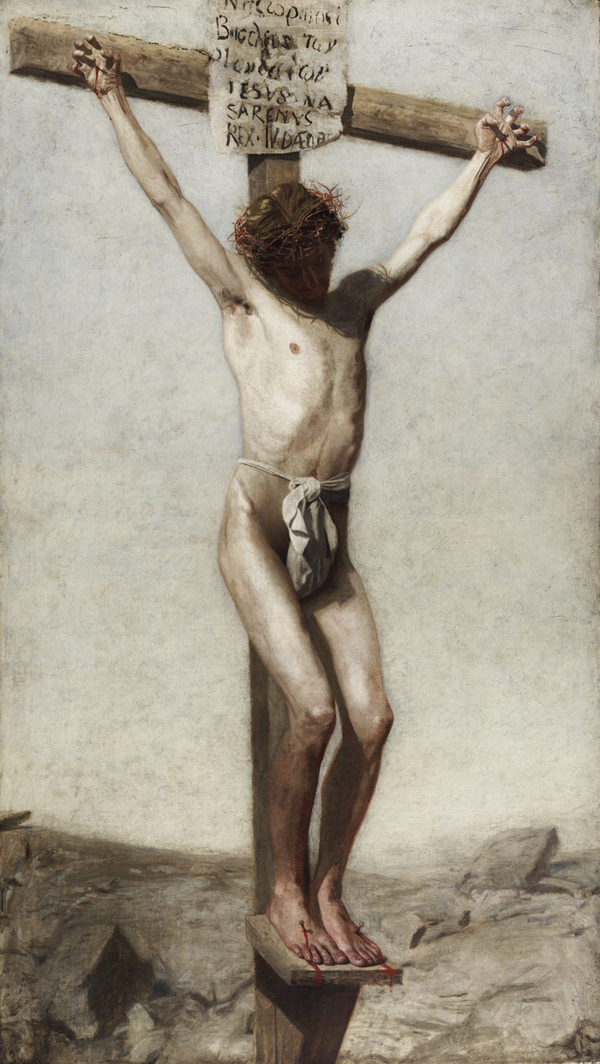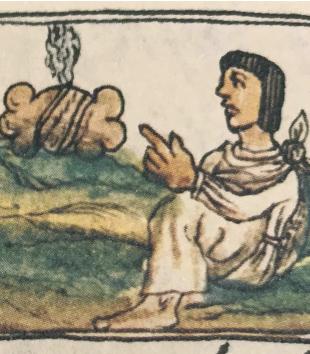During the summer of 1880, the Philadelphia artist Thomas Eakins began work on The Crucifixion, the only Biblical subject that he ever undertook. An ardent realist, who had trained at the prestigious Ecole des Beaux Arts in Paris, Eakins built his reputation on carefully studied portraits and genre scenes of life in and around Philadelphia. For The Crucifixion, Eakins’s methods were no less scrupulous. He took his sixteen-year-old student J. Laurie Wallace across the Delaware River to the marshes in New Jersey, where the artist made sketches of his model posing on a large wooden cross. In the finished painting Eakins, a reputed agnostic, crafted a realist interpretation of one of the central devotional subjects in Christian art. Although large in scale, the work was not done on commission or with a religious patron in mind; instead Eakins sent the painting to major international exhibitions. In later life, he came to regard the painting as his “best work” and hoped that a museum might acquire it.
For this painting, Eakins challenged the traditional iconography of the crucifixion by eliminating all signs of divine presence. Eakins accomplished this through several means that suggest his careful consideration of the subject for a modern audience. Most obviously, he treated the subject as a daytime scene, eliminating the miraculously darkened noonday sky described in three of the gospel texts. In doing so, he broke with a centuries-old iconographic tradition meant to convey Christ's divinity. The daylight helps to highlight the human presence of Jesus, whose thin body bears evidence of prolonged physical suffering, with blood pooling at his feet and his hands contracted in a claw-like response to the pain. In addition, Eakins did not add a halo to Jesus’ downcast head. According to the artist’s friend, the critic William J. Clark, Eakins intended, through his intensely realistic approach to the subject, “to conceive of the crucifixion as an event which actually occurred under certain understood conditions.”1 Eakins’s decision to paint Jesus in this way coheres with the work of the French academic painters with whom he trained. Like his teachers, Eakins was probably influenced by the work of nineteenth-century Biblical scholars, such as Ernst Renan, who attempted to recover the “historical Jesus” by using archaeological evidence to reconstruct his life and works.2 Through such interventions, Renan and others attempted to present Jesus as an historical figure, supporting his religious role with evidence of his life and work.
The painting also accords with what we know of Eakins’s personal religious beliefs. Although raised as a Protestant, Eakins was not especially religious. In fact, in letters written during his student days in Paris he expressed deep skepticism of religious dogma and was particularly critical of the Catholic clergy. He felt that church hierarchy should not mediate between God and the faithful; for him, belief lay in the heart and not in ritual. In later years, Dennis Cardinal Dougherty, a friend of the artist, described him as an agnostic who did not believe in the divinity of Christ.3
Eakins’s decision to paint Jesus as a man and not a God had consequences for the way that critics received the painting. Some critics considered the subject, and Eakins’s realistic treatment of it, inappropriate for a public art exhibition. Protestant critics, who drafted the most scathing critiques of the painting, negatively identified the subject with Catholicism since the cross actually bore the corpus or body, approximating, more closely, a crucifix rather than a cross. This being said, the same critics were also quick to note that Eakins’s human Jesus lacked divinity and thus would not appeal to Catholic viewers. Indeed, according to art historian Elizabeth Milroy, Eakins lent the painting to the Catholic Saint Charles Borromeo Seminary in Overbrook, Pennsylvania, but the seminarians hid the painting behind a door, instead of placing the work on view in the sacred spaces of the seminary.4 Many critics simply found Eakins’s graphic representation of Christ’s body “revolting.”5 Mariana van Rensselear was one of the few critics to appreciate the image; she found the picture deeply moving, viewing it as a modern pathos-filled depiction of the subject.6
Eakins crafted a distinctly modern crucifixion that challenged contemporary religious beliefs. In both religious and secular realms, Eakins’s crucifixion disquieted viewers with its emphasis on Christ’s material presence. So who did he paint it for? It seems unlikely that a church or even a private patron would have purchased such a large and polemical work. In spite of the controversy generated by the painting, Eakins continued to send it to major international exhibitions and actively approached museums, hoping that they might buy the picture. In the end, he found no takers, but his wife later included The Crucifixion in a gift of her husband’s paintings to the Philadelphia Museum of Art. Eakins's desire to reinvent the subject of the crucifixion for a modern audience engages in a dialogue with the Old Master tradition and, in doing so, demonstrates his artistic ambitions. Eakins’s modern crucifixion challenged both religious belief and artistic conventions, helping to define it for the artist as his “best work.”
Notes
Notes
1. William J. Clark, “The Fine Arts,” Evening Bulletin (Philadelphia), November 1, 1882, 5.
2. Renan's most famous work is Vie de Jésus (Life of Christ) first published in 1863 and available online at perma.cc/M4ZR-ER48
3. Dennis Cardinal Dougherty to Sir Shane Leslie, April 10, 1948, Lloyd and Edith Havens Goodrich Collection, The Thomas Eakins Research Collection, Philadelphia Museum of Art.
4. Elizabeth Milroy, “’Consummatum est . . .’: A Reassessment of Thomas Eakins’s Crucifixion of 1880,” Art Bulletin 71 (June 1989), 283. doi:10.1080/00043079.1989.10788499
5. Undated clipping (1883), The Detroit Art Loan Scrapbook in the Detroit Art Loan Association Records, Archives of American Art.
6. “Fine Arts: Exhibition Notes,” Independent, May 11, 1882, 9. Mariana van Rensselaer, “Society of American Artists, New York—II,” American Architect and Building News 11 (May 20, 1882): 231.
Keywords
Imprint
10.22332/con.obj.2014.46
1. Akela Reason, "Thomas Eakins, The Crucifixion," Object Narrative, in Conversations: An Online Journal of the Center for the Study of Material and Visual Cultures of Religion (2014), doi:10.22332/con.obj.2014.46
Reason, Akela. "Thomas Eakins, The Crucifixion." Object Narrative. In Conversations: An Online Journal of the Center for the Study of Material and Visual Cultures of Religion (2014). doi:10.22332/con.obj.2014.46



